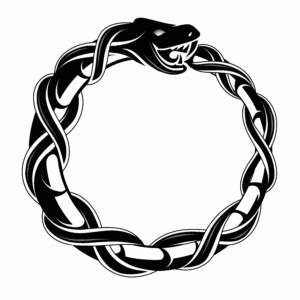The Serpent That Eats Itself? Understanding the Ouroboros

The ouroboros, and ancient symbol, has endured until modern times while powerfully embodying many physical and esoteric concepts.
As purveyors of wisdom, representations of fertility, or masters of deception, serpents have evoked both fear and awe from human beings for thousands of years. Unsurprisingly, they’ve also gained an association with hidden knowledge, transformation, and renewal. One ancient symbol, the ouroboros, has endured until modern times while powerfully embodying these and other esoteric concepts.
What Is the Ouroboros?
The Encyclopedia Britannica offers a short explanation of the ouroboros’s history and meanings. With roots in ancient Egypt and Greece, this emblem depicts a serpent coiled in a circle with its tail inside its own mouth. A Greek-English lexicon hosted by the Perseus Digital Library reveals that our modern version of the word comes from an ancient Greek term that translates to “devouring its tail.”
Ironically, this symbol with a Greek name didn’t originate in any ancient Hellenistic cultures. BBC Culture writer Joobin Bekhrad clarifies that the oldest representation of an ouroboros appeared on a golden shrine located inside Tutankhamen’s tomb. Its contents, including the shrine, have been dated to the 13th century B.C.E. German Egyptologist Jan Assmann added that the ouroboros stood for the “mystery of cyclical time.” Ancient Egyptians would have seen these tendencies reflected in the Nile’s flooding cycles and the movements of the sun.
Wibbly-Wobbly, Timey-Wimey Stuff
Egyptian views on the nature of time aren’t surprising, given that many other older civilizations believed that it operated in cycles rather than a strictly linear path. The “wheel of life” and “wheel of time” concepts arose within Indian religions such as Hinduism and Buddhism, and both the Mayan and Aztec cultures regarded time as cyclical.
Curiosity writer Reuben Westmass discloses that modern thinkers refer to this concept as “eternal return.” Supporters of the idea include German philosopher Friedrich Nietzsche and proponents of the “Big Bounce” theory who insist that the universe blows up, expands, and contracts in continually repeating cycles.
Not only that, discourse on these ideas is common in pop culture. One example comes from a 2007 “Doctor Who” episode in which the protagonist exclaims, “People assume that time is a strict progression of cause to effect, but actually from a non-linear, non-subjective viewpoint, it’s more like a big ball of wibbly-wobbly, timey-wimey stuff.”
Time, Space, and Alchemy
Bekhrad also explains that the ouroboros symbol was adopted by Greek alchemists during the Alexandrian era of Egyptian history. Within alchemic practice, it retained its original connotations of endless cycles and eternity. This emblem also possesses connotations of rebirth and renewal, considering how snakes regularly must shed their skins.
The Symbol Dictionary’s visual glossary discloses that it became associated with the spirit of Mercury, which is thought to be the essence that infuses all matter. A double ouroboros, or two snakes swallowing each other, stands for volatility as well as a balance between the higher and carnal selves of each human being.
Modern esoteric believers borrowed from and expanded upon these and other older alchemic traditions when using the ouroboros in their practices. Thelemapedia illuminates some of these additional meanings, referring to it as both a paradox and a “purifying sigil.” For some, it can stand for the unification of one’s primary presenting personality and the shadow self. Others may see it as an endless process of destroying and regenerating aspects of the self. In turn, it can become a representation of immortality.
An Existence That Never Ends?
Symbols can take on many different meanings, depending on who’s using or interpreting them. Contemporary worries about climate change, political turmoil, and economic instabilities lead some to wonder whether humanity will survive past the end of the 21st century. If nothing else, the ouroboros may be a sign of hope. Perhaps by prompting us to seek renewal and change, it can inspire us to face these challenges.

